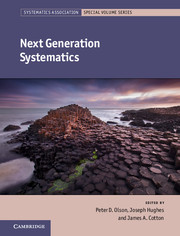Book contents
- Frontmatter
- Contents
- List of contributors
- Introduction: studying diversity in an era of ubiquitous genomics
- Part I Next Generation Phylogenetics
- Part II Next Generation Biodiversity Science
- Part III Next Generation Challenges and Questions
- Index
- Systematics Association Special Volumes
- Plate section
- References
Introduction: studying diversity in an era of ubiquitous genomics
Published online by Cambridge University Press: 05 June 2016
- Frontmatter
- Contents
- List of contributors
- Introduction: studying diversity in an era of ubiquitous genomics
- Part I Next Generation Phylogenetics
- Part II Next Generation Biodiversity Science
- Part III Next Generation Challenges and Questions
- Index
- Systematics Association Special Volumes
- Plate section
- References
Summary
Just as scientific discoveries enable the development of new technology, novel technologies can drive scientific progress. Similar to the adoption of PCR as a mainstream laboratory technique in the 1990s, the ability to readily sequence whole genomes today has opened up new areas of biology and fundamentally changed the way people work in existing fields.
The most obvious feature of so-called ‘next generation’ sequencing (NGS) technologies (a misnomer that includes a wide array of platforms developed over the past decade) is the enormous increase in throughput of sequence data, resulting in an unprecedented reduction in cost. A single sequencing ‘run’ of a high-end platform can generate up to 5 billion reads and determine the sequence of 1500 billion bp of DNA – the equivalent of 500 human genomes – in 3 to 4 days. The US National Human Genome Research Institute has tracked the changing price of DNA sequencing they fund from about $5000 per Mb to 5 cents per Mb over the last 15 years: a 100 000-fold drop (see Fig 1). At the time of writing (2015) the sequencing equipment market is dominated by Illumina, and a relative lack of competition and the maturity of the current technology has at least temporarily slowed the fall in price. However, the development of newer sequencing platforms is expected to soon spark another era of rapidly declining prices and rising throughput.
This enormous technological progress has been a boon for many areas of biology, but the change in technology has also required researchers to change the way they do science and has led to changes in the types of questions people can ask. Traditional sequencing required massive amplification of specific, targeted DNA sequences by PCR prior to sequencing. While it is possible to sequence PCR amplicons with high-throughput sequencing technology (and PCR is used in the sequencing process), the enormous throughput and short sequencing reads typically mean that the most cost-effective way of collecting even limited amounts of data of interest is by shotgun sequencing.
This untargeted approach opens up new kinds of science. For example, it is now possible – indeed, often technically easier – to assay entire genomes rather than investigate candidate genes.
- Type
- Chapter
- Information
- Next Generation Systematics , pp. 1 - 10Publisher: Cambridge University PressPrint publication year: 2016

